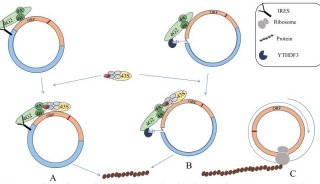Cloning of small RNAs with 5’ phosphate and 3’ OH ends-3
Load your precipitated PCR samples into 2 consecutive lanes so as not to overload the lanes. For each different sample, I would run a separate ladder so that the gels can be cut and stained separately OR run individual gels for individual samples to avoid contamination.
Stain the gels in 0.5X TE /EtBr in a clean container for 4 to 5 minutes.
Cut out ~92 bp band with a clean razor blade and put band into a 0.5 ml microtube whose bottom has been punctured 3 to 4 times by a 21 gauge needle. The adaptor-adaptor band runs around 70nt.
Place this tube into a 2 ml round-bottom microtube and spin the gel through the holes into the 2 ml tube (2 min spin at full speed in microfuge).
Add 300 µl of elution buffer to the gel debris and elute the DNA by shaking the tube gently at 30°C for 1 hour and then rotating overnight at 4°C (we’ve also done 4°C overnight).
Transfer the eluate and the gel debris into a Spin-X filter. Spin the filter in the microfµge for 2 minutes at full speed.
Add another 100 µl of elution buffer to the gel debris and then spin for another 2 min at top speed to collect the extra eluate in the same tube.
Add 1 µl of Pellet Paint® (that has been brought to room temperature and vortexed very well), 40 µl of 3 M NaOAc and 1000ml of EtOH. Put at -20 for 1 hour to overnight or at -80 for 20 minutes. Spin at 14K for 25 mins to pellet.
Wash with 750 µl of RT 70% EtOH, speed vacuum dry, and resuspend in 15µl of sterile resuspension buffer (10mM Tris-HCl pH 8.5).
Quantification of small RNA PCR products.
Mix 1 µl of the resuspended small RNA PCR product with 2 µl of water for nanodrop determination. Do the same with 1µl of resuspension buffer + 2µl of water for the blank.
Take the following Nanodrop readings. Remember that your sample is a 3X dilution, so multiply the final concentration by 3.
230
260
280
260/280 (want 1.8 for pure DNA)
260/230
ng/µl (see section "Materials & Reagents" for correction factor used for the Pellet Paint)
Mix 1 µl of your PCR product with 4 µl water and 5 µl DNA loading dye. Run your samples on a 10% native gel along with 0.5 µg (5µl of the dilution) of the 100bp Generuler Fermentas Ladder. If 0.5µg (5µl) is loaded, the 100bp band is 40 ng. Use the Quantity One software to determine the concentration of your PCR products.
Take an average reading between the nanodrop and the BioRad quantification. You will use this number to determine the Molarity of your library (comment 6).
Determine the molarity of your library
Size of cloned small RNAs (average is 93bp for Arabidopsis small RNAs)
Molecular mass = 93bp x 650 = 60450
60450 g = 1 mol or 60450 µg = 1 µmol
Concentration of library in µmol/ml = [ng/µl]/60450
i. Example, if PCR product is 16ng/µl. The concentration of the library is 16/60450 = 0.000264 µmol/ml = 0.264 µmol/L or 264nM
Back to top
Materials & Reagents
| SuperScript™ II Reverse Transcription Kit (10,000 Units) | Supplier: Invitrogen Catalog #: 18064-014 |
| RNAguard 5000U | Supplier: GE Healthcare Catalog #: 27-0815-01 |
| Generuler 100bp ladder | Supplier: Fermentas |
| 20bp ladder low ladder | Supplier: SIGMA Catalog #: P1598-40UG |
| Phusion™ High Fidelity DNA Polymerase (100U) | Supplier: NEB Catalog #: F-530S |
| dNTP Solution Set (4x25µm) | Supplier: Invitrogen Catalog #: 10297-018 |
| T4 RNA Ligase (50 U)+10X buffer | Supplier: Promega Catalog #: M1051 |
| Glycoblue 15mg/ml | Supplier: Ambion Catalog #: AM9516 |
| Nuclease Free Water | Supplier: Ambion Catalog #: AM9938 |
| RNase-free 2 mL microfµge tube | Supplier: Ambion Catalog #: AM12425 |
| Non-stick RNase-free 0.5 mL microfµge tube | Supplier: Ambion Catalog #: 12350 |
| Pellet Paint®NF Co-precipitant | Supplier: VWR Catalog #: 70748-4 |
| Spin-X Cellulose Acetate Filter (2 mL, 0.45 µm) | Supplier: Fisher/SIGMA Catalog #: MPA-150-040Q/CLS8162 |
| mirVANA microRNA isolation kit | Supplier: Ambion Catalog #: AM1561 |
| 1.5ml Siliconized eppendorf tubes | Supplier: SIGMA Catalog #: T4816-250EA |
| 2x Gel Loading Buffer II | Supplier: Ambion Catalog #: AM8546G |
| pGEM T-easy cloning vector kit | Supplier: Promega Catalog #: A1360 |
| Big Dye v. 3.1 | Supplier: ABI |
| EtOH | |
| Isopropanol | |
| 0.5X TBE diluted from 10X TBE stock | |
| 0.3 M NaCL diluted from 5M stock | |
| 3 M NaOAC pH 5.2 | |
| Resuspension Buffer (10 mM Tris-HCl, pH 8.5) | |
| Biorad Mini Protean II gel apparatus | |
| Deionized formamide |
Back to top
Author Notes
Adapter specifications used in the Baulcombe lab. Please note, the sizes used in this protocol are based on the sizes of the adapter molecules and PCR primers. If you use primers/adapters of other sizes, then you need to adjust the sizes cut out of the gels accordingly.
5’ RNA adaptor = 26bp of an RNA:DNA hybrid molecule. The three 3’ bases are RNA and the rest is DNA (ordered through Dharmacon). We dephosphorylated before use.
3’ RNA adaptor = 23bp of RNA/DNA hybrid molecule. The 5’ base is phosphorylated. The three 5’ bases are RNA the rest is DNA. The 3’ end of the of the adapter has an inverted thymine moiety (iDT) (ordered through Dharmacon)
Small RNA RT-primer: DNA oligo complementary to the 3’ adapter
Small RNA PCR Primer 1: identical to the RT primer
Small RNA PCR Primer 2: We use a DNA oligo 44bp long that incorporates the 5’ adapter but adds a tail at the 5’ end to increase the length of the PCR product.
Back to top
Reviewer Comments
Reviewed by: Eric Miska, Gurdon Institute, Cambridge
We use mirVana kit followed by gel purification. This allows precise size selection of small RNAs by preventing any smears from overloaded lanes on the gel.
Alternatively, the Criterion system can be used. We find it most important to exclude any cross-contamination of samples at this point. One sample per gel would be ideal.
We find eluting from an intact gel slice as effective and easier to handle. It is important to prevent any gel “bits” to be included in the precipitation step.
We find it useful to pick colonies onto a rectangular agarose plate in an 8x12 grid. We the set up the PCR reactions using a 96 well replicator. Positive clonies can then easily be identified for sequencing.
More than 17 cycles will likely just result in empty amplification: you will get many identical reads instead of increased sequencing depth.
As concentration is absolutely critical, it would be useful to check samples additionally on a BioAnalyzer.
Back to top
Figures

Figure 1. Overview over the flow of the cloning procedure
-
科技前沿

-
焦点事件










